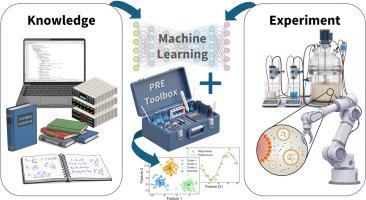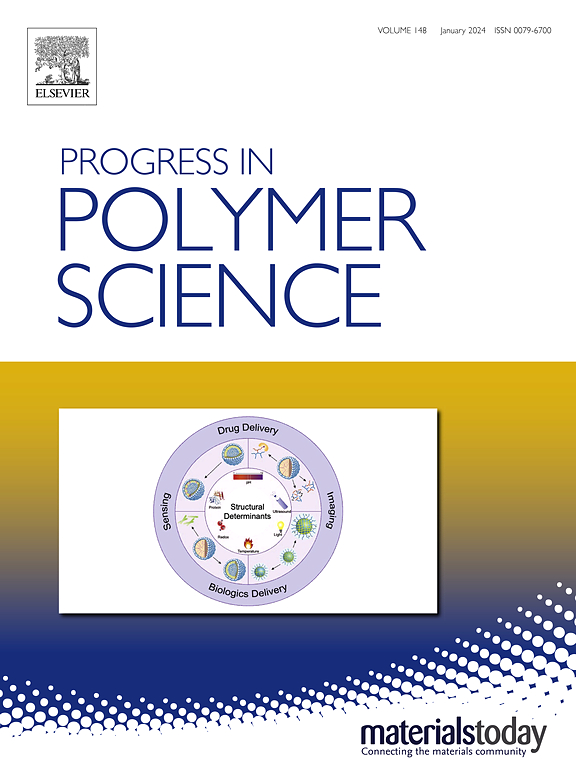将机器学习添加到聚合物反应工程工具箱
IF 26.1
1区 化学
Q1 POLYMER SCIENCE
引用次数: 0
摘要
数学建模长期以来在大分子体系的发展中起着至关重要的作用,为设计聚合物材料以实现特定目标提供了一个框架。传统上,这些模型是建立在基本物理和化学过程的第一性原理知识基础上的。然而,近年来,数据驱动的方法,特别是那些基于机器学习(ML)的方法,已经获得了巨大的吸引力。与受预定义假设约束的传统模型不同,ML模型提供了更大的灵活性,这既可以产生积极的结果,也可以产生消极的结果。从积极的方面来看,机器学习模型的灵活性使得它们对于分析复杂系统特别有用,例如聚合物材料中常见的系统,这些系统通常很难用传统方法完全捕获。然而,一个众所周知的缺点是,他们缺乏身体基础,有时会导致不切实际的预测。在这篇综述中,讨论了在聚合物反应工程领域使用机器学习的最新进展,特别关注如何将第一原理和数据驱动的数学模型的优势结合起来。本文首先概述了当前可用的关键机器学习技术,然后探讨了它们在聚合物系统建模中被证明有益的具体应用场景。在深入讨论了聚合物反应工程应用的最新技术之后,文章最后对这一新兴领域的未来进行了展望,概述了进一步研究的关键挑战和机遇。本文章由计算机程序翻译,如有差异,请以英文原文为准。

Adding Machine Learning to the Polymer Reaction Engineering Toolbox
Mathematical modeling has long played a crucial role in the development of macromolecular systems, offering a framework for designing polymeric materials to achieve specific targets. Traditionally, these models have been grounded in first-principles knowledge of the underlying physical and chemical processes. However, in recent years, data-driven approaches, particularly those based on machine learning (ML), have gained significant traction. Unlike conventional models, which are constrained by predefined assumptions, ML models offer greater flexibility, which can have both positive and negative consequences. On the positive side, the flexibility of machine learning models makes them particularly useful for analyzing complex systems, such as those common to polymeric materials, which are often challenging to fully capture with traditional approaches. However, a well-known drawback is that their lack of physical grounding can sometimes result in unrealistic predictions. In this review, recent advances in the use of machine learning in the field of polymer reaction engineering are discussed, with a particular focus on how to incorporate the strengths of both first-principles and data-driven mathematical models. The review begins with an overview of the key machine learning techniques currently available and then explores specific scenarios where their application has proven beneficial in modelling of polymeric systems. Following an in-depth discussion of the state-of-the-art with respect to polymer reaction engineering applications, the article concludes with a perspective on the future of this nascent field, outlining key challenges and opportunities for further research.
求助全文
通过发布文献求助,成功后即可免费获取论文全文。
去求助
来源期刊

Progress in Polymer Science
化学-高分子科学
CiteScore
48.70
自引率
1.10%
发文量
54
审稿时长
38 days
期刊介绍:
Progress in Polymer Science is a journal that publishes state-of-the-art overview articles in the field of polymer science and engineering. These articles are written by internationally recognized authorities in the discipline, making it a valuable resource for staying up-to-date with the latest developments in this rapidly growing field.
The journal serves as a link between original articles, innovations published in patents, and the most current knowledge of technology. It covers a wide range of topics within the traditional fields of polymer science, including chemistry, physics, and engineering involving polymers. Additionally, it explores interdisciplinary developing fields such as functional and specialty polymers, biomaterials, polymers in drug delivery, polymers in electronic applications, composites, conducting polymers, liquid crystalline materials, and the interphases between polymers and ceramics. The journal also highlights new fabrication techniques that are making significant contributions to the field.
The subject areas covered by Progress in Polymer Science include biomaterials, materials chemistry, organic chemistry, polymers and plastics, surfaces, coatings and films, and nanotechnology. The journal is indexed and abstracted in various databases, including Materials Science Citation Index, Chemical Abstracts, Engineering Index, Current Contents, FIZ Karlsruhe, Scopus, and INSPEC.
 求助内容:
求助内容: 应助结果提醒方式:
应助结果提醒方式:


